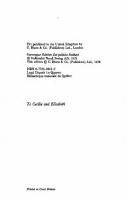Polar bears in Svalbard 82-7666-215-3
301 17 540KB
English Pages 15 Year 2005
Cover......Page 1
Polar Bears in Svalbard......Page 3
Be armed......Page 4
Weapon ready......Page 5
If you have to shoot the bear......Page 6
Polar Bear Biology......Page 7
Polar Bear Facts......Page 8
Hunting,Laws and Regulations......Page 9
Climate change......Page 10
Pollution......Page 11
Norwegian Polar Institute......Page 15
Recommend Papers

- Author / Uploaded
- Jon Aars
- Magnus Andersen
- Kit M. Kovacs
File loading please wait...
Citation preview
Polar Bears in Svalbard
Contents
Page
ThePrecautionaryPrinciple....................3 PolarBearsinSvalbard .........................3 PolarBearsandHumans........................4 PolarBearBiology.............................7 PolarBearFacts ...............................8 Hunting,LawsandRegulations ..................9 PolarBearResearch ..........................10 ContactInformation...........................12
Photo:T.I.Karlsen
PublishedbytheNorwegianPolarInstitute PrintedJanuary2005 ISBN82-7666-215-3
Text:JonAars,MagnusAndersen,KitM.Kovacs. Editors:GunnSisselJaklin,JanetHolmén. Illustrations,design/layout:AudunIgesund. Photofrontcover:HansWolkers. Allwildlifephotographstakeninconjunctionwithscientificwork.
setthegoalofhavingSvalbardbe“oneof thebestmanagedwildernessareasinthe world”.Toachievethisgoal,itisvitalthat visitorsandresidentsfollowregulationsand helppreservethisuniqueHighArcticwildernessareaanditsfloraandfauna.
Photo:T.I.Karlsen
ThePrecautionaryPrinciple Polarbearsareimpressivecreatures.They aretheworld’slargestlandcarnivores andformanypeopletheyhavebecomea symbolofArcticwilderness.LiketheArctic theyhavecometorepresent,polarbears arebeautiful,butdangerous.Occasionally, humanencounterswithpolarbearshave afataloutcome–eitherforthepeople involved,thebear(s)orboth.Byfollowing thePrecautionaryPrinciple(keepyourdistance),wecanavoidsuchtragicoutcomes. Norway’spolarbearpopulationlivesinand aroundSvalbard;thesebearsareactuallypartofapopulationthatinhabitsthe NorthernBarentsRegion,includingRussian territoryeasttoFranzJosefLand.Norwegianauthoritiestaketheirstewardshipofthe polarbearinNorwayandthepreservation ofitshabitat–theSvalbardArchipelago –seriously.TheNorwegianGovernmenthas
Thisbrochureprovidespracticalinformation regardinghowtoconductyourselfwhenin polarbearterritoryinordertoavoidconflict andhowtobehaveshouldyouaccidentally comeintoasituationwhereyouhaveclose contactwithapolarbear.Theaimisthatthe informationgivenhereshouldmakeitclear whybaiting,pursuingoractivelyseeking polarbearsisillegalinSvalbard.
PolarBearsinSvalbard Thepolarbear,Ursusmaritimus,isclosely relatedtothebrownbearfromwhichit evolvedabout200000-300000yearsago. Despitetheshorttimesincethesetwo speciessplit,thepolarbearhasundergonesignificantmorphologicalchangesin becomingadaptedtothespecificdemands theArcticenvironmentputsontheanimals livingthere.Themostobviousoftheseadaptationsisthewhitefur.Thebeautifulfurwas theprimaryreasonthisspecieswashunted fromthetimeoftheearlyexplorers,sealers, andwhalers,andlater–startingaroundthe turnofthelastcentury–byspecializedpolar beartrappers(seeHunting,LawsandRegulations).Populationsizesdecreasedrapidly throughouttheworldinthe1900suntilpolar bearharvestingbecameregulatedfollowing thesigningofaninternationaltreatyin1973.
Twentydifferentpolarbearpopulationsare recognizedthroughouttheArcticregion. Svalbard’spolarbearsoccupytheareafrom SpitsbergeninthewesttotheRussianarchipelagosofFranzJosefLandandNovaya Zemlyaintheeast.Thesebearsarereferred toastheBarentsSeapopulation. Femalepolarbearsontheeastcoastof Svalbarddisplaytwodifferentmovement patterns.Someindividualsroamoverlarge areas,rangingfromtheirdenningareasin SvalbardacrosstoRussianterritory,spendingmostoftheirtimealongthesouthernlimitsoftheArcticicehuntingforseals.Other individualshavealessenergydemanding lifestyle,occupyingmuchsmallerhome rangesthatarerestrictedtoSvalbardandits adjacentwaters;thesebearshaveashorter huntingseason. Thereissomemovementofbearsbetween theBarentsSeapopulation,theeastern Greenlandpopulationinthewestandthe KaraSeapopulationintheeast,butexchangebetweenthesegroupsislimited.The BarentsSeapopulationprobablycontains overthreethousandpolarbears.ApproximatelyhalfofthesebearsarelocatedprimarilyonoraroundtheislandsofSvalbard.The maindenningareasinSvalbardarelocated onKongKarl’sLand,Hopen,Edgeøyaand Nordaustlandet.ThetinyislandofKongsøya hasthehighestrecordeddensityofpolar beardensintheworld:in1980atBogenon Kongsøyatherewere12densperkm²and inAugust1984,168bearswereobservedon theisland!
3
PolarBearsandHumans
Precautions
Polarbearsarepotentiallydangerous animals,andyoushouldnevermovearound inpolarbearterritorywithoutbeingwellprepared.InSvalbard,peoplehavebeenkilled onseveraloccasions,includingincidentsin recentyears.Onaverage,threebearshave beenkilledeveryyearduringtheperiodfrom 1993to2004inencounterswithhumans,i.e. inself-defence.Thisnumbercanbekept lowifpeopletrytoavoidcriticalencounters, andbehaveinthemostsensiblewaywhen interactingwithbears.Accidentswithfatal outcomesarehighlyunlikelyifyoufollowa fewsimpleprocedures.
Gainknowledgeaboutpolarbears
Learnabouttheanimalsandthedangerthey canrepresentbeforeenteringpolarbear country–particularlyifyouareplanningto movearoundoutsidethesettlements.Study thisfoldercarefullyandcontacttheGovernorofSvalbardortheNorwegianPolar Institute(seeaddressesattheback)ifyou requirefurtherinformation.
Avoidconfrontations
Payattentiontoyoursurroundingsatall timesandbepreparedtomeetpolarbears wheneverandwherevertravellingorcampinginSvalbard.Takemeasurestoavoid confrontationsanddangeroussituations.If youspotabearatadistance,avoidanencounterbystayingoutofitspath,andnever movetowardthebear.Thecallofadventure orthedesiretotakephotographsdoesnot justifyputtingyourself,yourcompanionsor thepolarbearindanger.
Bearmed
Photo:F.Jørgensen
Polar bear sign in Longyearbyen: “Valid for all of Svalbard”.
4PolarBearsinSvalbard
Alwayshaveasufficientlypowerfulweapon athandwhentravellinginSvalbardoutside thesettlements.Bepreparedtoscare awayapprochingbearsusingascaring device(seep.6).Polarbearsarelarge andformidable,andawoundedbearisa “worst-casescenario”.Humanfatalities haveoccurredinSvalbardwhenpeople havedefendedthemselvesagainstpolar bearswithweaponsofinsufficientcalibre. Ahighpoweredbiggamerifle(calibre.308 win,30-06orheavier)isthebestweaponfor
Photo:K.M.Kovacs
Polar bears usually give clear signals prior to an attack, when they become anxious, but many of these cues can be quite subtle. Bears under stress often flatten their ears, turn their heads away from the source of the stress, let their lips hang or yawn. More assertive signals can include front-foot stamping, growling or brief charges. But – attacks can also happen very quickly and without warning! protectionagainstpolarbears,andhunting cartridgeswithexpandableleadcorebullets aretheonlyrecommendedammunition.The onlyalternativeweaponisapumpaction shotgunwithrifledslugs(calibre12);such aweaponmustbeabletoaccommodateat leastfourcartridgesinthemagazine.Make surethatyouarefamiliarwithyourweapon tothepointwhereyoucanaimitandoperateitunderstress.Ifyouhavenevershot before,getinstructionsandtrainingfroman experiencedperson.
Campinginpolarbearcountry Camplocation
SomeareasinSvalbardaremoreproneto havepolarbearactivitythanothers.Avoid settingupcampsinareaswhereencounters aremostlikely.Polarbearsoftenfollowthe shoreline,bothinsummerandwinter,so campsshouldalwaysbeplacedsomedistancefromtheshore,preferablywithagood viewinalldirections.Avoidcampingnear thefrontofglaciers,closetoravinesand narrowvalleysorclosetopossibledensites. Alwaysavoidsettingupacampinareas wheretherearepolarbeartracks.
Detectionsystems
Allcampsshouldbesurroundedwithtrip wiresorhaveotherpolarbeardetection systems.InSvalbard,asystemwhere
Trip wire.
thewireisconnectedtoaflare(that explodesandburnswithabrightlight)is mostfrequentlyused.Thewiresshouldbe placedseveralmetresawayfromthetents, preferablyattwoheights(about30cmand 70cmabovetheground).Well-traineddogs canbeusedtogiveearlywarningthatthere arepolarbearsaroundthecamp.Theycan detectbearsatalongdistance,butifabear approachesfromdownwind,thereisarisk thatthedogmaynotpickupthescentof thebear.Dogsusedtodetectbearsshould alwaysbetiedupoutsidethetents.Another goodsolutionistohavearevolvingguard system,suchthatthecampisalwaysbeing watchedbyadesignatedperson–particularlyatnightwheneveryoneelseisindoors sleeping.
Cookingandfoodstorage
Polarbearscansmellfoodoververylong distancesanddangeroussituationscan arisewhenbearsareattractedbyfoodat campsitesorcabins.Itisthereforeimportant tostorefoodsecurely,inamannerthatpreventsbearsfromhavingaccesstoit–away fromsleepingtents.Packfoodinplastic orplaceitinsidefoodboxestoreduce theodour,andbeparticularlyalertwhen preparingfoodoutdoors.Avoidcooking strong-smellingfoodinsidetents,because theodourremainsinthetentcanvasfor prolongedperiods,makingthemattractive tobears.Youmustneverusefoodtoattract polarbearsandneverfeedthem.Bearsthat havebeenfedbecomebolderinapproachingpeopleandthereisanincreasedlikelihoodofencounterswherethebearwillbe shotorpeoplehurtorkilled.
Wastedisposal
Polarbearsare attractedbythesmell ofgarbageandwaste. Theywillcometo checkifanything ediblecanbefound. Polarbearsvisiting wastedumpsnear settlementsareaproblemthroughoutthe Arctic.Inacampsituation,wasteshouldbe storedsomedistanceawayfromthemain campgroundinaspotthatcanbemonitored easily.
Firearms
Alwayshavethegunclosebyandtakeit withyouwheneveryoumovearoundin camporgooutonexpeditions.Besurethat yourgunisingoodserviceablecondition andthatitisclean–oilcanjamagunifit iscoldoutside.Toavoidaccidents,keep thechamberempty;keepshellsreadyin aloadedmagazine.Otherbeardeterrent equipment(flares)andextrashellsshouldbe keptsothattheyareeasilyfoundshoulda bearenterthecamp.
Encounterswithpolarbears Weaponready
Haveyourweaponreadyforuse,butputa shellintothechamberonlywhenthebear issoclosethatyoufeelthesituationis threatening.
5
Assessthesituation
Polarbearsdonotusuallylookuponhumans asfood.Buttheyarenaturallycuriousand willcheckouteverythingintheirsearchfor food.Areallyhungrybearwilleatalmost anything.Younganimalsareoftenthemost dangerous;theyareinexperienced,have limitedhuntingskillsandmayhaveahard timecatchingprey.Butolderweakanimals thathavetroublecatchingnormalpreycan alsobedangerous.Bearscanbeaproblem iftheygettakenbysurpriseandfeelthey havetodefendthemselves.Femaleswith youngcubsareusuallyquiteshy,butifyou surprisethembysuddenlyappearingata shortdistance,theyarealsoverydangerous becausetheywilldefendtheircubs. Alsoworthnotingisthatifthereisone bearinthearea,chancesaregoodthereis anotheronearoundtoo.Maybethefemale walkingawayfromyouisbeingfollowedby amale.Maybethebearyouseeisanadolescentcubashortdistancefromitsmother.
If forced to shoot a polar bear, aim at the chest or the shoulder.
6PolarBearsinSvalbard
Mostbearswillrunawaywhenconfronted byhumans,oratleastattempttoavoidan encounter,eveniftheyarecurious.Many situationscanbeassessedwithsomecommonsenseandknowledgeofbearbehaviour.Ifthereistime,yourfirststepshouldbe todeterminewhatkindofpolarbear(s)you aredealingwith,andwhetheritisinterested inyouornot.Remembertoplayitsafe, though.Itisalwaysbestnottocountonthe bearavoidingyou.
Makeyourselfvisible
Ifthebearmovesdirectlytowardyou,make yourselfvisibleearlyandalsomakenoise. Shoutingandclappingofhandsorstarting anengine,i.e.asnowmobileoroutboard enginewillmakethebearawareofyou. Thismaybeenoughtocausethebearto withdraw.
Warningshots/flareshots
Ifthebear’sinterestinyouorthecamp continues,youshouldbepreparedtousea signalpistolwithcrackcartridges,orshoot awarningshotfromarifletoscareitaway. Startpreparingtotakeactionwhenthebear
isstillatsomedistance.Flareshotsare thebestequipmentforthis(i.e.betterthan usingarifle).Aimsuchthattheflarelands betweenyouandthebear(i.e.notbehind thebear).Ifyouareusingarifle,becareful nottoshootintothegroundtooclosetothe bear,becausericochetsmayhurttheanimal. Ifthebearisalreadymovingtowardyou, aimtoonesideoraboveitsheadtoavoid hittingitaccidentally.Continueshootingrifle shotsorflaresuntilitretreats.Innearlyall casesthiswillbesufficienttoscarecurious orevenaggressivebearsaway.Ifthereare traineddogsinthecamptheycanbelet looseatthispoint.Dogsthatshowaggressiontowardspolarbearsoftenareefficient atchasingbearsaway.
Ifyouhavetoshootthebear
Ifanaggressivebearattackswithnosignof beingscaredawaybywarningshots,shoot withtheaimtokill.Thisisalastresort.Aim forthechest,belowthehead,eitherfrom thefrontortheside.Donotattemptashotin theheadbecausetheskullofpolarbearsis toughandwellprotectedbyheavymuscles, andthevulnerableareaissurprisinglysmall evenonabigbear.Keepshootinguntilthe bearliesstill,anddonotapproachituntil youaresureitisdead.Eventhenapproach thebearfrombehind.Donotmovethebear orremoveanythingfromthescene.Contact theGovernorofSvalbardimmediately.
PolarBearBiology Thepolarbearisamarinemammal,even thoughmostpeoplewillseeitonland.Polar bearshavebecomespecializedateating sealsandhencedomostoftheirhunting outontheseaice.Theyroamoverhuge expansesandadultanimalscanswimlong distanceswhenrequiredtodoso. InSvalbardthepolarbear’smainpreyspeciesareringedsealsandbeardedseals, althoughharpsealsmightalsobeimportant preyinsomeoffshoreareas.Anadultpolar bearneedstokillbetween50and75seals annuallytomeetitsenergyrequirements. Itusesdifferentmethodstogetholdofthe seals,suchaswaitingpatientlybesidea breathing-holeintheiceorsneakingupona sealhauledoutontheice. Polarbearsarelong-livedmammalsthat havelowreproductiverates.Hence,when lefttothemselves,theirpopulationsize changesslowly.InSvalbard,mostadult bearsdiebeforetheageof30.Mostfemale polarbearsreproduceforthefirsttimewhen theyareaboutfiveyearsold.Atthisage theyusuallygivebirthtooneortwocubs whowillremainwiththemforthenexttwo andahalfyears.Thenthefemalemates againandwilltypicallyhavecubsabout everythreeyearsfortheremainderofher life.Cubsoftendiewhentheyarequite young,inwhichcaseafemalecangivebirth againthefollowingwinter.Middle-aged femalesusuallyhavetwocubs,butlittersof threedooccur.
MostcubsarebornaroundNewYear’sDay, weighingonlyalittlemorethanhalfakilo. However,theygainweightquicklyoverthe nextmonthsintheden,drinkingthenutritious,fat-richmilktheirmotherprovides. Cubsweighupto10kginlateMarchor earlyAprilwhenthefamilyleavestheden. Atthistimeoftheyearsealhuntingisexcellent:thisiswhenringedsealshavetheir pups,whichareborninlairsontheseaice inthefjordsaroundtheislands. InthefjordsinSvalbard,particularlyon theeastcoastofSpitsbergen,femalepolar bearsarefoundinlargenumbers,actively
Photo:K.M.Kovacs
huntingtofeedtheirgrowingyoung.Male bearsalsocomeintotheseareas,inthe hopeofmatingwiththefemalessometime betweenAprilandJune.Competitionfor matingisintense,andoftenmanymalescan beseenfightingforaccesstoafemale. Thefurofapolarbeartendstobeyellowish insummer,whereasitiswhiterinwinter. Theskinisblack.Polarbearsmovequickly, butcannotmaintainhighspeedoverlong distances.Ifchasedbyasnowmobile,for instance,bearscanoverheatandtheycan evendieofheatstroke.
Photo:K.M.Kovacs
Bears that become trapped on land when the sea ice retreats northward in the spring/summer can face months of starvation. hese emaciated animals (left) will readily turn to nontraditional prey – such as people – if they are presented with an opportunity to hunt. Well-fed bears (such as the one on the right) are less likely to look at humans as potential food.
7
PolarBearFacts • Anexcellentswimmer;consideredamarinemammalasitspendsmostofitslifeonseaice andfeedsatthetopofamarinefoodchain • Feedsalmostexclusivelyonice-livingseals • Cansurviveupto8monthswithouteating • Caneasilywalkover5000kmayear • Movesquickly,reachingaspeedofmorethan30km/hovershortdistances • Hasawelldevelopedsenseofsmell • Typicallyweighs400-600kg.Malesarelargerthanfemales • Cubsweighonlyabout600gatbirth
Photo:H.Wolkers
Female bear with cubs. hese females are usually quite shy. But they can be dangerous – attacking readily in defense of their young.
8PolarBearsinSvalbard
Hunting,LawsandRegulations InSvalbard,polarbearswerehuntedheavily intheperiodfromthelate1800suntil1973.In the1920smorethan900bearsayearwere killedinSvalbard,andevenafterWWIIthe numbersofbearskilledannuallywereas highas400-500.Duringthelast25-30years beforethetreatyenteredintoforce,harvestingdecreasedsomewhat,butstillseveral hundredpolarbearswerekilledeachyear inSvalbard.Around1970therewereprobablynomorethan1000polarbearsleftin Svalbard,andthepopulationwasindanger ofextinction. Polarbearshavebeenhuntedinmanyways throughtheyears–withguns,trapsand
evenpoison.Boats,aircraftandhelicopterswereusedduringsafarihuntsinthe 1950s,whenwealthyhunterspaidforthe expeditions.Themostefficienthuntingwas performedusingset-guns.Eachtrapperhad aseriesoftheseautomatedbaitedgunsin theirhuntingterritory,andsomeindividual trappersbroughtbackmorethan100hides attheendofaseason.Although“efficient” thesegunshuntedindiscriminately,woundingsomebears,andkillingmothersofcubs. Otherfactorsalsocontributedtodepleting thepopulation.Inadditiontoadultsbeing killed,alargenumberofcubswerebrought backtoEuropefromSvalbardandplaced inzoos.
In1973,TheInternationalAgreementfor theConservationofPolarBearsandTheir Habitat(referredtoastheAgreement)which co-ordinatestheoverallmanagementof polarbearsworldwide,wassignedbyall countriesthathavepolarbearpopulations (USA,Russia,Canada,Greenland/Denmark andNorway).TheAgreementwasdesigned tostopthedeclineinpolarbearpopulations aroundtheglobeandtoconserveareaswith importanthabitatwithintheircircumpolar range.Itwasalsodesignedtosafeguardtraditionalhuntingoftheanimalsbyindigenous peoplesintheArctic.TheAgreementdirects allsigningpartiestoconductresearchto ensuresoundmanagementofpolarbear populations,andcreatesaninternational forumwherethedifferentnationscanexchangeinformationandshareadvice. InSvalbardtherewererestrictionsonpolar bearhuntingasearlyas1927,whenthe useofpoisoninthepolarbearhuntwas prohibited.In1939animportantdenning area,KongKarl’sLand(landareas),was declaredclosedtohunting.Shootingofcubs andfemaleswithcubswasprohibitedin 1965.Despitetheserestrictions,polarbears inSvalbardwereheavilyover-harvested untiltheInternationalPolarBearAgreement cameintoeffect.
Photo:Ing.Klingenberg
Old polar bear trap at Kapp Martin.
Severallocallawsandregulationsin Svalbardarerelevanttohowhumansshould actinrelationtopolarbears.TheSvalbard EnvironmentalProtectionAct,Regulationsrelatingtotourismandothertravelin Svalbard,Regulationsrelatedtoharvesting andRegulationsrelatingtocampingactivi-
9
tiesinSvalbard,allprotecttheenvironment inSvalbardandthuspolarbearsandtheir habitat.Inareaswithparticularlyhighpolar beardensitysuchasthenationalparks onSpitsbergenandtheeasternpartof Svalbard,travelrestrictionsapply,especially travelwithsnowmobiles.OnKongKarl’s Landaccessisprohibitedonayear-round basisbecauseofthehighdensityofpolar bearsandthefactthatsomanybearsden ontheseislands. ItisprohibitedthroughoutSvalbardandsurroundingwaterstobait(lure),pursueorotherwiseseekoutpolarbearsinsuchaway astodisturbthemorexposeeitherbearsor humanstodanger(SvalbardEnvironmental ProtectionAct,§30). Legal,restrictedhuntingofpolarbearstakes placeinmostotherArcticareas.TheBarentsSeapopulationisuniqueinbeingunder noharvestingpressure.Althoughthe populationsizeintheBarentsareaisnot knownprecisely,itisclearthatpolarbears haverecoveredconsiderablyinSvalbard since1973.
Photo:M.Andersen
10PolarBearsinSvalbard
PolarBearResearch TheNorwegianPolarInstitutehasconductedapolarbearresearchprogrammefor manydecades.Inthe1960s,animalswere taggedandsamplesweretakenfrommany oftheanimalsthathadbeenkilledbyhunters.Today,theresearchisdoneexclusively onliveanimals.Muchofthefieldwork isperformedusinghelicoptertransport, enablingtheresearcherstoaccesslarge numbersofanimalsoverbroadgeographic areas.Inanaverageyear,approximately 100bearsarecapturedandmeasuredand thedataareusedinavarietyofstudies. Morethan1000bearshavebeenmarked since1990.Approximately100femaleshave beenfittedwithsatelliteradiotelemetry transmitterstoregistertheirmovements.A rudimentarytoothistakenfromallanimals olderthanoneyearofagethefirsttimethey arecaptured,toestimatetheirage.Over time,datacollectedduringthecaptureand recaptureofindividualanimalswillprovide estimatesofsurvivalandreproductiverates. Thisisimportantinformationthatcanhelp predictpopulationgrowthandpopulation viability. Recentadvancesinthefieldofgenetic researcharealsobeingputtouse.Genetic markerscanrevealalotaboutthebiology ofaspecies.Bloodandtissuesamplesare collectedfromallbearscaptured,makingit possibletodeterminefamilyrelationsand populationstructure.Thedegreeofgenetic differentiationbetweenbearsfromdifferent denningareas,andfromSvalbardversus areastothewestandtheeast,tellshow
muchpolarbearsmovebetweentheareas. Thishasimplicationsforhowquicklythe polarbearswillbeabletoadapttochanging conditions,forinstancewhethertheywillbe stronglyaffectedifclimatechangemakes somedenningareaslesssuitable.Genetic techniquesalsomakeitpossibletomonitor pastandfuturechangesinpopulationdistributionduetochangingconditionssuchas huntingpressureandhabitatavailability.
Climatechange
Climatechangeisexpectedtocauseserious problemsforpolarbears;recentresearch onArcticclimateshowsalarmingtrends.It ispossiblethattheicecoversurrounding theNorthPolewilldisappearinsummer withinthiscentury,andthattheperiodeach winterduringwhichnewiceisformed–ice thatcoversthefjordsandareasaroundthe islandsandprovidespolarbearswiththeir primehuntingground–willgetshorter. Reductionsintheamountofsuitablehabitat andincreaseddifficultyhuntingsealswould haveaprofoundeffectonpolarbears. Weatherconditionsduringthedenningperiodwillalsobeaffectedbyclimatechange, andthismightbedetrimental:polarbears needlargevolumesofsolidsnowinwhich todigtheirdens.Lessseaicealsocreates adangerthatdifferentpopulationswill becomeisolatedfromoneanother,which wouldhaveanegativeimpactonthegenetic variabilitywithinpopulations,andincrease thedangeroflocalextinction.Finally,lackof availablefoodinthesummertimecouldalso leadtomoreconfrontationswithhumans.
Pollution
Theothermainthreattopolarbearsisthe factthatalarminglevelsofseveraltoxic compoundshavebeenobservedinthe Arctic.Windandoceancurrentstransport toxinstotheBarentsSearegion.Polar bearsandotherpredatorsareatparticular riskastheyareatthetopofthefoodchain, consumingprey(fish,sealsetc.)thathave accumulatedpollutantsfromlowertrophic levels.Thehighlevelsofthepersistent organicpollutantPCBandotherfat-soluble pollutantsinpolarbearsareacausefor concern.Athighconcentrations,pollutants mayaffectvitalfunctionsandthereproductivesystem,andhavebeenshowntoaffect immunesystemresponses.Intensivework isbeingconductedtomonitorthelevelsof toxinsintheanimals.Althoughthepolar bearpopulationhasgrowninaperiodwith highlevelsofpollutants,interactionswith otherfactors,suchasclimatechange,may increasethenegativeimpactoftoxinsonthe averagelifespan.Itisthereforeimportantto continuemonitoringprogrammes.
Protectyourselfandpolarbearsbybeing smartandplayingitsafeinpolarbear country.
Scientists from the Norwegian Polar Institute checking an anaesthetized polar bear’s teeth (above) and taking blood and fat samples (below).
Photos:A.Derocher
11
ContactInformation NorwegianPolarInstitute PolarEnvironmentalCentre,NO-9296Tromsø [email protected] Tel.:+4777750500
TheGovernorofSvalbard P.O.Box633,NO-9071Longyearbyen fi[email protected] Tel.:+4779024300
InformationontheInternet NorwegianPolarInstitute..................................................................................www.npolar.no TheGovernorofSvalbard..................................................................................www.sysselmannen.svalbard.no TheIUCNPolarBearSpecialistGroup............................................................pbsg.npolar.no TheInternationalAssociationforBearResearchandManagement.........www.bearbiology.com
Photo:H.Wolkers
DirectorateforNatureManagement Tungasletta2,NO-7485Trondheim [email protected] Tel.:+4773580500









